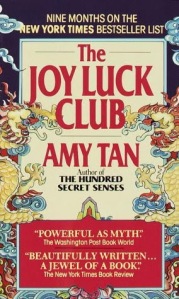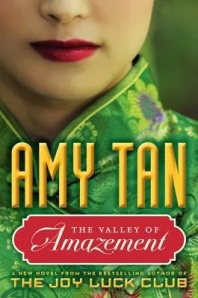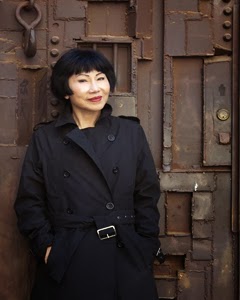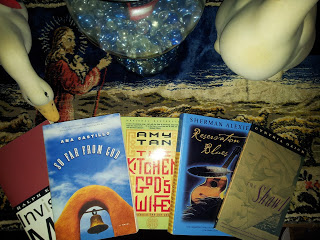 I have said it once and I’ll say it again: I love Amy Tan. I loved her since I was too young to grasp The Joy Luck Club as a novel, but was spellbound by the movie like it was nobody’s business. See, the movie was the perfect introduction to a ten-year-old because it quickly filled my head with sad stories about brave Chinese women, lost babies, and that un-belongingness I identified with as a youth. The spice to my transfixed state rested on the movie’s cultural surroundings. It was here that I got a glance into stringent conventions and traditions that bound Chinese women in a culture so foreign to me. So naturally, I grew to want more understanding of all that I‘d witnessed. The movie sunk into me at ten and never resurfaced to drift way.
I have said it once and I’ll say it again: I love Amy Tan. I loved her since I was too young to grasp The Joy Luck Club as a novel, but was spellbound by the movie like it was nobody’s business. See, the movie was the perfect introduction to a ten-year-old because it quickly filled my head with sad stories about brave Chinese women, lost babies, and that un-belongingness I identified with as a youth. The spice to my transfixed state rested on the movie’s cultural surroundings. It was here that I got a glance into stringent conventions and traditions that bound Chinese women in a culture so foreign to me. So naturally, I grew to want more understanding of all that I‘d witnessed. The movie sunk into me at ten and never resurfaced to drift way. When I was finally old enough I managed to read the novel and became a fan of Tan’s literary works from then forward. I ate her books and stories--if you will. And while the general consensus is that The Joy Luck Club lay in the majority of favorites among her readers (and undoubtedly her most popular novel), my personal love goes out to The Kitchen God’s Wife. Besides being a thicker novel, I believe I loved it just a little more because I spent more time with the mother and daughter pair, Pearl and Winnie, and their respective narratives. I say this as opposed to the various working characters and narratives in The Joy Luck Club. In essence, Pearl and Winnie hung around a little longer to tangle me--as the reader--in their mother/daughter strife.
When I was finally old enough I managed to read the novel and became a fan of Tan’s literary works from then forward. I ate her books and stories--if you will. And while the general consensus is that The Joy Luck Club lay in the majority of favorites among her readers (and undoubtedly her most popular novel), my personal love goes out to The Kitchen God’s Wife. Besides being a thicker novel, I believe I loved it just a little more because I spent more time with the mother and daughter pair, Pearl and Winnie, and their respective narratives. I say this as opposed to the various working characters and narratives in The Joy Luck Club. In essence, Pearl and Winnie hung around a little longer to tangle me--as the reader--in their mother/daughter strife.Nevertheless, I am a slave to Tan’s ethnic settings and illuminating mother/daughter themes, as well as that often used expression of “rich prose” that she uses. Tan can take me to places far away and can take me to places close to home all at once. I’ve waited eight years for something new from her (besides her Rules for Virgins Kindle Single) and it has finally arrived in the form of her 2013 release of The Valley of Amazement. Spending those eight years between authors like Pearl S. Buck and Ha Jin wasn’t so bad, but I was certainly awaiting Tan’s return. Good or bad, I spent my time reading The Valley of Amazement cutting my fingers in an excited rush through some parts, while using the book as a pillow during others. It seems that while the device of using Chinese courtesans to move the novel was enlightening in the beginning, it was also the one thing that eventually pulled me away from engaging with the story fully during the later half of the book. In turn, maybe even the characters.
 I’ll attempt to not spoil the novel by sharing an overview of the material. The Valley of Amazement takes place in late 19th century to early 20th century between Shanghai and San Francisco. Told through the eyes of the mother/daughter narrative-sharing duo, consisting of Violet and her mother, Lulu, the story starts with Violet sharing a rundown of her current status as a lonely American girl living in Shanghai. However, Violet’s mother is white while her father is Chinese. Violet is unaware of this, while comfortably raised within a high-class courtesan house owned by her mother. So she is exposed to much, but ignores what her true heritage consist of considering the physical signatures that make up her face.
I’ll attempt to not spoil the novel by sharing an overview of the material. The Valley of Amazement takes place in late 19th century to early 20th century between Shanghai and San Francisco. Told through the eyes of the mother/daughter narrative-sharing duo, consisting of Violet and her mother, Lulu, the story starts with Violet sharing a rundown of her current status as a lonely American girl living in Shanghai. However, Violet’s mother is white while her father is Chinese. Violet is unaware of this, while comfortably raised within a high-class courtesan house owned by her mother. So she is exposed to much, but ignores what her true heritage consist of considering the physical signatures that make up her face.In other words, she is in denial of her Chinese make up.
According to Violet she is American and fair-skinned--nothing else. And it’s this attitude that causes her torment as a child by her academic peers. She eventually leaves school, but her arrogance increases as the story moves forward with her development and eventual change. Nonetheless, to young Violet, being and thinking Chinese means kowtowing to statues and ghosts and following old traditions simply because that was how things were done thousands of years ago. Violet saw herself as too fearless and modern to be Chinese.
Violet is somewhat of a princess inside her mother’s popular courtesan house, and with that status and position comes an unhinged feeling that she isn't completely loved by her busy and inattentive mother. So when a Chinese stranger comes into the courtesan house to speak exclusively with Violet’s mother, a prying Violet catches wind of a lost little brother that she has. Her feelings of being unloved only intensifies at her mother’s angered response toward the stranger, who dredged up old memories, mistakes, and love unknown to Violet. Suddenly, San Francisco is where Violet's mother sets her destination in locating her lost son; it's home. The problem is getting there aboard a month long voyage on a steamer. Reservations are required. Passports are needed. And considering Violet's mother suddenly finds her daughter's birth certificate misplaced, a visit to the American Consulate becomes necessary before the actual voyage. A time crunch is pressed upon her.
It's here where Violet's mother make another big (and totally avoidable) mistake that sends her newly teenage daughter into the hands of a second-class courtesan house with her virginity up for auction as a virgin courtesan. Everything Violet believed about herself is stripped away while her mother sails to San Francisco.
Did I give away too much? Nah! Trust me when I say this book goes a long way from Violet's troubled beginning. About a quarter toward the end of the book the narrative switches to Violet's mother's history and point-of-view of the events. Unfortunately, by the time I got to Lulu's narrative I was nearly worn out on the whole subject of courtesans and women having their sex taken or auctioned off to men. Particularly toward the very last bit of the first arc that housed Violet's narrative. The book is littered with themes concerning trust, and these women never seen to make the right connection toward it until it hits them in the face. Nevertheless, I'll keep that relative to the reader, so you have to read the book and their journey to really decide whether or not the women could do more with their decisions or lack thereof. But the way Tan painted the characters in the beginning of the book left me feeling as if they only managed to do less than what I believed they were capable of. An example would be how Violet's mother, Lulu, found herself in power and status as a high-class courtesan house owner, yet she suffered through her mistakes by not applying the resources she created for herself.
I felt a lot of "do this; problem solved" in this book.
 |
| Credit: Rick Smolan/Against All Odds |
This leads to another particular I had about the book. There were moments of disconnect that I felt for the characters. As the reader I seemed to see things the characters didn't see. With all of the great descriptions and glimpses of history and of a courtesan's lifestyle, none covered the feeling I got that I was witnessing the events that took place as opposed to living them with the characters. So when the plot devices set up, I just saw the characters walk into them.
The book often took on a strong telling atmosphere in this case, as if Lulu and Violet were feeding me (as the reader) information more than living it on the page as they moved through the plot. Now there were certainly some solid, emotional moments in the book that moved me into feeling the character's experience. One was Violet's violent reaction when she found herself in the low-class house. I cheered for her flash of anger. Then a couple of pages in she was damn near complacent with her position as the virgin courtesans. Many areas of the novel felt like this; set-up when pages later the experience passes and the character dwell on it lightly. Or even loosely.
I still thought it was a great novel. It told an obvious but great story. I think the key essence in the novel wasn't so much the story per say, but more of the communication between mothers and daughters and relationships. As well as consequences for not communicating (which in some areas they did shamefully to fulfill a plot device). All that is usual to Tan--which is why I love her. I suppose it was told a little "lightly" in this book because there was a sort of testingness (I often make up words) to it. Nonetheless, we get to explore themes on trust and abandonment and how loving the wrong person can lead us to the wrong (some may even say right) places only so many times. Eventually the characters find or reclaim some value in themselves, so that's a solid ending. The book didn't ground me in like Tan's older novels, but it was a force of its own and very much worth reading a second time.
The secret ingredient to this novel is Magic Gourd. I'll leave it at that.




